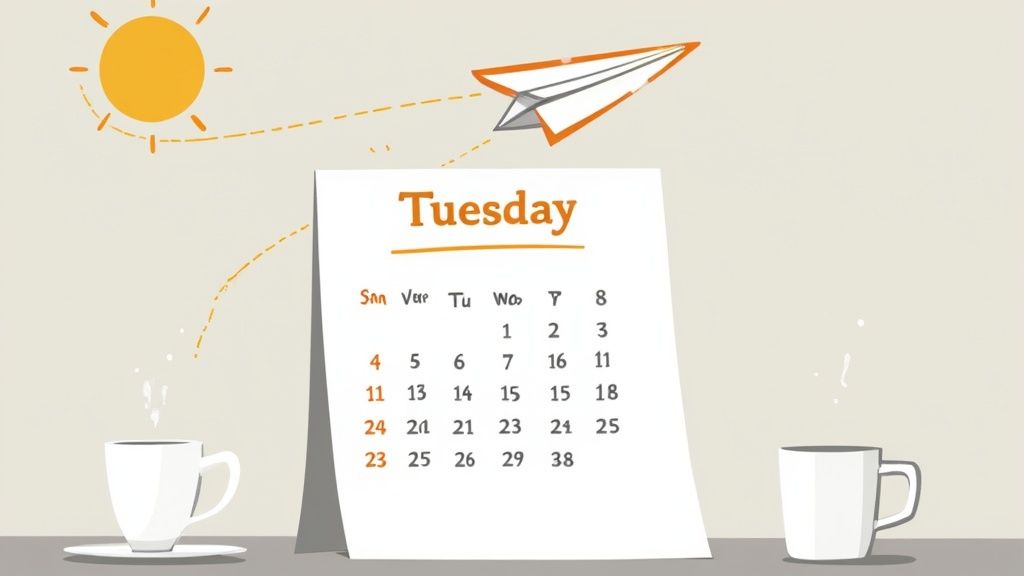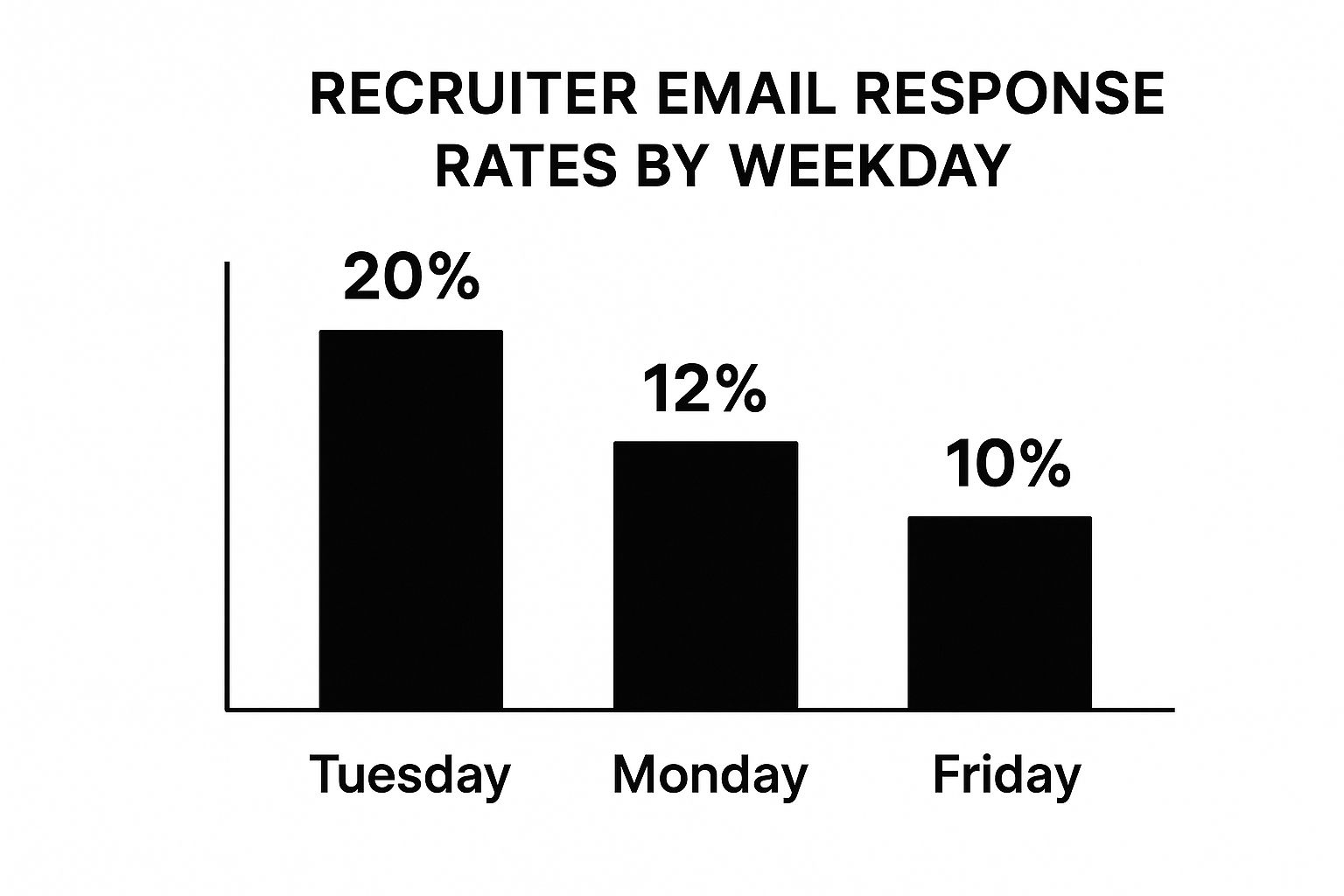
What Is the Best Day to Apply for a Job?
You’ve polished your resume, perfected your cover letter, and you’re staring at the “submit” button. Does it really matter if you click it now versus tomorrow morning?
Absolutely. Timing is one of the most underrated parts of a successful job search. Data consistently points to one day as the clear winner: Tuesday.
The Surprising Truth About When You Apply
It’s easy to feel like you’re just tossing your application into a black hole. But what most people don’t realize is that recruiters and hiring managers have a pretty predictable weekly rhythm. If you can sync your application with their peak activity, you instantly stand out.
This guide will show you how to stop guessing and start using a data-backed strategy to get noticed.
Why Timing Your Application Is a Game Changer
Think of a recruiter’s inbox on a Monday morning. It’s overflowing with emails from the weekend and internal catch-up meetings. An application sent on a Friday afternoon? It’s likely to be buried by Monday’s chaos.
Applying at the right time is like catching a wave perfectly. It gives you momentum. Here’s why it works:
- You Get Top-of-Inbox Visibility: Sending your application when a recruiter is actively sourcing means you’re right at the top of their list, not buried 100 emails deep.
- You Match Their Workflow: You’re catching them when their primary focus is finding great candidates, not when they’re swamped with end-of-week reports or back-to-back meetings.
- It Shows You’re Serious: A timely, early-in-the-week application sends a subtle signal that you’re organized, proactive, and genuinely interested.
A great resume is your ticket to the show, but strategic timing is what gets you a front-row seat. It amplifies the impact of your qualifications.
The data backs this up. Studies consistently show applications submitted between 6 a.m. and 10 a.m. from Tuesday to Thursday get significantly more attention. And of those days, Tuesday morning is the undisputed champion for getting a callback. You can dig deeper into the data on optimal application times to see just how big the difference is.
Ready to understand the “why” behind these numbers? Let’s break down the hiring game from an insider’s perspective.
Weekly Job Application Timing at a Glance
To make this simple, here’s a quick rundown of what the week looks like from a recruiter’s desk and how you can plan your submissions accordingly.
| Day of the Week | Optimal Time Window | Recruiter Activity Level | Why It Matters |
|---|---|---|---|
| Monday | Mid-morning (10 AM - 1 PM) | Moderate | Recruiters are catching up. Applying mid-morning avoids the initial email flood. |
| Tuesday | Early morning (6 AM - 10 AM) | Peak | This is the sweet spot. You land in their inbox as they begin actively sourcing. |
| Wednesday | Early morning (7 AM - 11 AM) | High | Still a strong contender. Recruiters are deep into candidate review. |
| Thursday | Mid-morning (10 AM - 2 PM) | Decreasing | A good backup day, but attention starts shifting toward wrapping up the week. |
| Friday | Avoid if possible | Low | Applications often get buried over the weekend. Recruiters are focused on deadlines. |
| Weekend | Avoid | Very Low | Your application will be old news by Monday morning. |
This table gives you a clear playbook. Aim for that Tuesday to Thursday window, and you’re already ahead of the game.
Why Tuesday Is the Peak of the Hiring Week
So, why does the data consistently point to Tuesday as the magic day to hit “submit” on your application? To understand this, you have to get inside the rhythm of a typical hiring manager’s week.
Think of Monday as the day for clearing the runway. Recruiters are catching up on a flood of weekend emails, attending team meetings, and mapping out their priorities. It’s all about planning and preparation.
But by Tuesday, the decks are clear. Recruiters are fully focused and ready to dive into their most important task: finding talented people like you. This is when they often post new roles and start digging into the first wave of applications that have come in. When you apply on Tuesday, your resume lands right on top of the pile for a fresh, urgent need.
The Power of Perfect Timing
Timing your application for a Tuesday puts you directly in the recruiter’s line of sight when their energy and motivation to hire are at their highest. You’re not just another name in a massive, week-old spreadsheet; you’re one of the very first contenders for a brand-new opening.
It’s all about being at the top of the list right as the search kicks off. Don’t just take my word for it—the numbers back this up. An analysis of over 270,000 job postings by SmartRecruiters found a clear pattern. Their data showed that a whopping 58% of all job postings go live between Monday and Wednesday, with Tuesday leading the pack. You can read more about these hiring cycle findings and see the full data breakdown for yourself.
Applying on Tuesday is like showing up to a store right as it restocks its most popular item. You get first pick before the crowds arrive.
This surge in activity creates a perfect, albeit brief, window of opportunity for you. To make the most of it, you need to be organized and ready to move fast. This is where using a dedicated job application tracker can be a game-changer, helping you stay on top of openings so you never miss that ideal application window. Being prepared is what allows you to turn these peak hiring moments into interviews.
Thinking Like a Recruiter: A Weekly Breakdown
To really nail down the best day to apply for a job, you’ve got to get inside a recruiter’s head. Their week isn’t just a random assortment of tasks; it follows a predictable rhythm. If you can understand that workflow, you can stop sending your resume into a black hole and start timing it for maximum impact.
Think of it this way: sending your application at 10 a.m. on a Tuesday is like a comedian delivering a punchline to a focused, receptive audience. Sending it at 4 p.m. on a Friday? That’s like trying to get a laugh when everyone is already mentally checked out and heading for the door.
The Recruiter’s Weekly Cadence
The hiring process has a natural ebb and flow that mirrors the standard workweek. Here’s a peek behind the curtain at how their priorities typically stack up, day by day:
-
Monday: Strategy and Catch-Up. Mondays are all about planning. Recruiters are buried in strategy meetings, sifting through a weekend’s worth of emails, and setting priorities. They’re teeing up the week, not actively digging for new candidates.
-
Tuesday & Wednesday: Action and Review. These are the prime-time sourcing days. With a clear plan in place, recruiters post new job openings and dive headfirst into the applicant pool. Their main goal is to find promising candidates and get those first interviews on the calendar.
-
Thursday: Interviews and Follow-Ups. By Thursday, the focus tends to shift. Recruiters are busy conducting phone screens, checking in with hiring managers, and following up with candidates who are already moving through the process.
-
Friday: Wrap-Up and Reporting. Fridays are for tying up loose ends. They’re finalizing weekly reports, updating the applicant tracking system (ATS), and prepping for the following week. Any new application that lands now will likely sit untouched until Monday morning.
Understanding this weekly cycle transforms your job application from a hopeful message in a bottle into a strategically timed delivery that arrives at the perfect moment.
This isn’t just theory—it’s a practical map of their attention span. Your objective is to have your resume land in their inbox when their mindset is laser-focused on “find new talent.” Aligning your submission with that window dramatically boosts your odds of being seen, reviewed, and contacted for that crucial first interview.
The Early Bird Advantage: How Time of Day Matters

Beyond picking the right day, when you hit “send” can give you another powerful leg up. Data shows that sending your application between 6 a.m. and 10 a.m. significantly increases your chances of getting seen by a real human.
It’s like being the first person in line for front-row tickets—you get the best spot. An early morning application lands at the top of a recruiter’s inbox, ready and waiting for them when they grab their coffee and start their day.
You’re catching them before the chaos of back-to-back meetings and urgent emails takes over. In those first couple of hours, they’re often at their freshest and most focused, dedicating time to screening new candidates. Your application gets prime attention.
Capitalizing on the Morning Rush
This isn’t just a hunch; it’s a strategy backed by real-world recruiter behavior. Time and time again, we see that applications sent early in the morning are far more likely to be opened, read, and moved to the “yes” pile.
By 11 a.m., the floodgates have usually opened, and the volume of applications peaks. If you wait, your resume has to fight for attention in a much more crowded space. The early bird doesn’t just get the worm—they get noticed before the inbox gets overwhelming.
This simple shift in timing can make all the difference. Here’s a quick rundown of why it works so well:
- You’re First in the Queue: Your application is literally one of the first things a recruiter sees.
- You Match Peak Focus: You’re aligning with the window when most people are at their most productive.
- You Avoid the Midday Flood: You stand out from the crowd before the majority of applications even arrive.
Of course, perfect timing won’t matter if your resume isn’t compelling. If you want to make sure your application is as strong as your strategy, check out our guide on how to tailor your resume to a job description. Pairing a knockout resume with smart timing is your best shot at landing that interview.
Are There Exceptions To The Tuesday Rule?
While the data clearly points to Tuesday as the top day to send in your job application, it’s not a silver bullet. If you stick to that rule too rigidly, you might actually miss out. The real trick is to blend the data-driven advice with a bit of smart, flexible strategy.
Think of it this way: if everyone rushes the same door at the same time, it creates a bottleneck. That’s the main argument against the “Tuesday rule.” Knowing it’s the prime day, tons of other candidates are flooding recruiter inboxes. This has led some savvy job seekers to try a more counterintuitive approach.
This visual breakdown of recruiter response rates really drives home why Tuesday gets all the attention.

As you can see, the response rate on Tuesday is nearly double what you’d expect on a Friday, which is exactly why it earned its reputation as the peak hiring day.
The Low Competition Approach
So, what’s the alternative? Applying during off-peak times, like a Friday afternoon or even over the weekend. The logic here is pretty straightforward: with far fewer applications coming in, yours has a much better shot at catching a recruiter’s eye. Jerome Ternynck, the CEO of SmartRecruiters, has even pointed out that applying during these quieter periods can be a strategic move to sidestep the initial rush.
The risk, of course, is that your application might get buried under the wave of new submissions that floods in on Monday and Tuesday. It’s a classic trade-off: do you want high visibility with high competition, or low competition with lower initial visibility?
Industry And Company Culture Matter
It’s also crucial to remember that not every company operates on a standard 9-to-5, Monday-to-Friday schedule. The “Tuesday rule” is most effective for traditional corporate jobs.
- Fast-Paced Tech Startups: In the tech world, things move at lightning speed. A job can be posted and filled in a matter of days. For these roles, the best strategy is simple: apply the moment you see the opening, no matter the day.
- 24/7 Industries: Think about fields like healthcare, hospitality, or logistics. Their hiring needs don’t stop for the weekend. Recruiting cycles are continuous, so the day you apply often matters a lot less.
To help you decide which path to take, here’s a quick comparison of the two main strategies.
Job Application Strategies Compared
| Strategy | Best Day/Time | Primary Advantage | Potential Downside |
|---|---|---|---|
| Peak-Time Application | Tuesday (10 AM - 2 PM) | Catches recruiters when they are most active and engaged. | Your resume is one of many in a crowded inbox. |
| Off-Peak Application | Friday, Saturday, Sunday | Faces significantly less immediate competition. | Risk of getting overlooked in the Monday morning pile-up. |
Ultimately, choosing between these strategies depends on your industry, the specific company, and your personal risk tolerance.
At the end of the day, a fantastic application is your strongest asset. For a deep dive into building a resume that gets noticed any day of the week, check out our complete guide on creating a resume for a job application.
Answering Your Questions About Job Application Timing
Even when you’ve got the data, a few specific situations always seem to pop up during a job hunt. Let’s dig into some of the most common questions I hear about timing your applications, so you can make the smartest call.
Does The Best Day To Apply Change For Different Industries?
You bet it does. While that Tuesday sweet spot works wonders for most corporate jobs, some fields just play by different rules.
Think about hospitality or retail—they’re often hiring around the clock and might be checking applications every single day, weekends included. On the flip side, in the tech startup world where everything moves at lightspeed, the day of the week matters far less than how quickly you apply after a job goes live.
Always factor in the culture of your target industry. A nimble startup isn’t going to hold off on a great candidate just because it isn’t Tuesday.
What If a Job Is Posted On a Friday?
If you see a perfect-fit role pop up late on a Friday, apply immediately. Don’t hesitate. A good rule of thumb is to try and get your application in within the first 48 hours of a job being posted.
Submitting on Friday afternoon is a thousand times better than waiting until the following Tuesday. Your application will be right there at the top of the pile when the recruiter gets their coffee on Monday morning. Think of the “Tuesday rule” as a general guide for your search, not a rigid order to delay for a hot new opening.
Think of it this way: a great resume is your ticket to the show, and strategic timing is what gets you a front-row seat. One doesn’t work well without the other.
How Important Is Timing Compared To My Resume Quality?
Let’s be crystal clear: your qualifications and a killer resume are always priority number one. A weak application sent at the “perfect” time is still going to land in the ‘no’ pile.
But when you have a strong application, timing is what gives it a serious edge. Submitting at an optimal moment dramatically increases the odds that an actual human being will see your materials before they get buried.
Timing doesn’t replace quality; it magnifies its impact. Nail your resume first, then use smart timing to make sure it gets the attention it deserves.
Don’t let creating documents hold you back from applying at the right time. Jobcamp uses AI to instantly create customized resumes and cover letters for any job, helping you apply at the perfect moment every time. Discover how to accelerate your job search with Jobcamp today.

